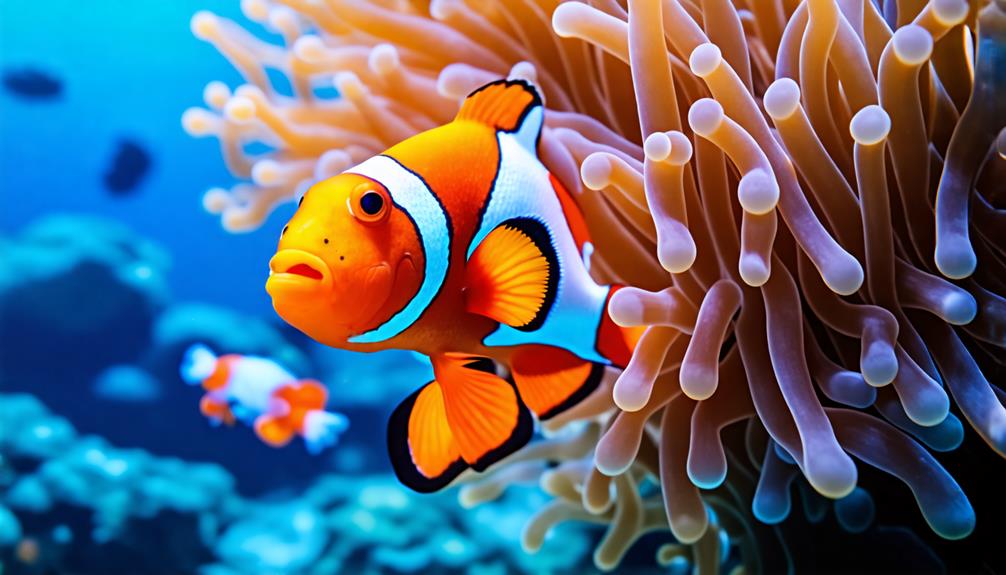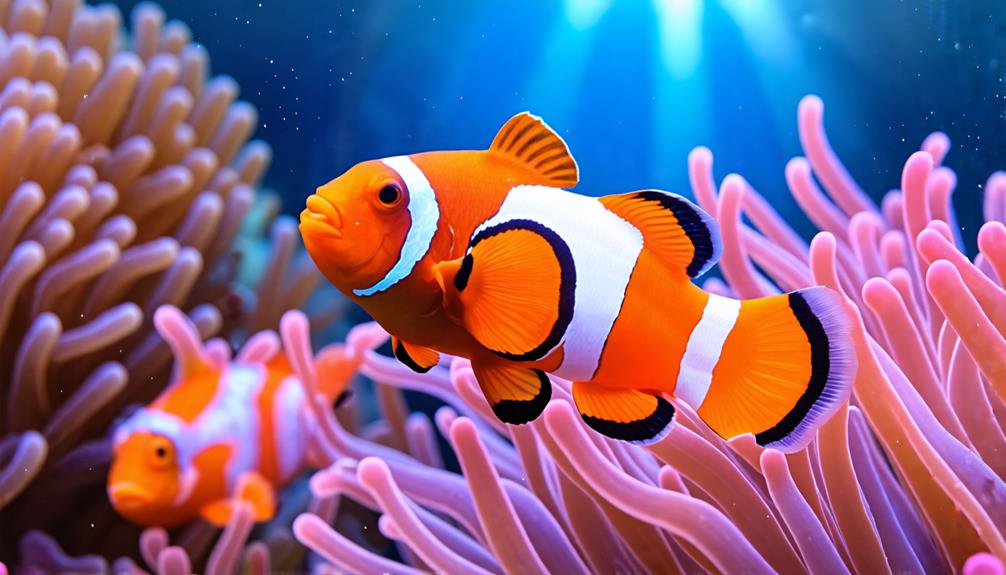You've probably seen clownfish in aquariums or movies, but did you know that every single one of them starts life as a male? This surprising fact is just the beginning of their fascinating reproductive journey. As these colorful fish grow and establish their social hierarchies, some undergo a remarkable transformation from male to female. This unique ability allows clownfish communities to adapt and thrive in their coral reef homes. But what triggers this change, and how does it affect the delicate balance of their underwater world? The answers reveal an intricate dance of nature that's both beautiful and essential for their survival.
Key Takeaways
- Clownfish exhibit protandrous hermaphroditism, meaning all individuals are born as functional males.
- The largest individual in a clownfish group becomes female, while the next largest remains male.
- This reproductive strategy maintains a social hierarchy within clownfish communities.
- Sex change is triggered by the death of the dominant female in the group.
Clownfish Reproductive Biology

When it comes to clownfish reproduction, you'll find a captivating world of gender-bending biology and dedicated parental care.
All clownfish are born male, but they possess the remarkable ability to change sex through sequential hermaphroditism. In a clownfish group, the largest individual becomes female, while the next largest remains male, forming the breeding pair. This sex change is triggered by the death of the dominant female, prompting the largest male to change.
The process involves irreversible neurological and behavioral changes, along with significant physiological adjustments. Breeding can occur year-round in warm waters, often aligned with full moon cycles.
The male takes charge of parental care, guarding and aerating the eggs for 6-10 days until they hatch. Notably, the clownfish's skin makes it immune to its host sea anemone's stings, providing a safe haven for reproduction.
Sex Change Mechanism
The fascinating sex change mechanism in clownfish is a complex physiological process that allows these fish to adapt to social and environmental changes within their anemone homes.
As protandrous hermaphrodites, all clownfish are born male, but they possess the remarkable ability to transform into females when necessary. This sex change is triggered by the death of the dominant female in a social group.
The dominant male then undergoes a series of neurological changes, altering its behavior and reproductive roles to become the new breeding female. This transformation is irreversible and vital for maintaining the social hierarchy within the group.
The sex change mechanism guarantees that there's always a breeding pair available, with the largest fish becoming the dominant female and the next largest becoming her mate.
This flexible reproductive strategy helps clownfish populations thrive in their unique ecosystem.
Ecological Significance

Clownfish serve as fundamental contributors to the health and biodiversity of coral reef ecosystems through their unique ecological roles and relationships. You'll find these vibrant fish playing an important role in maintaining the well-being of sea anemones through their symbiotic relationship. This partnership not only benefits the clownfish and anemones but also enhances overall reef biodiversity.
Here's how clownfish impact their environment:
- They provide nutrients to anemones and remove parasites
- Their presence increases anemone population health
- They occupy a specific niche in shallow, warm Indo-Pacific waters
- Their sex change ability guarantees population stability
As clownfish face threats from habitat loss and climate change, their conservation is essential for preserving reef ecosystems. By protecting these remarkable fish, you're helping to maintain the delicate balance of coral reef biodiversity.
Conclusion
You've discovered a fascinating aspect of marine life. Clownfish's unique reproductive biology showcases nature's adaptability.
As you ponder their sex-changing ability, remember it's essential for their survival. Next time you see these colorful fish, you'll know there's more than meets the eye.
Their complex social structure and reproductive strategy highlight the intricate balance in coral reef ecosystems. It's a reminder of how much we've yet to learn about the ocean's hidden wonders.

Leave a Reply